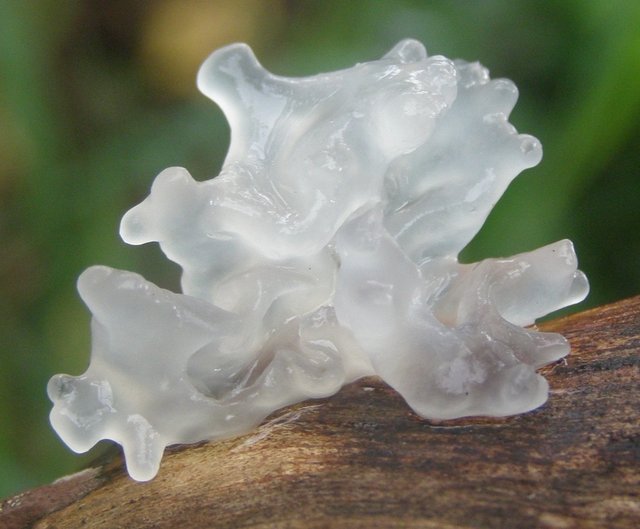Fucus shiver (Tremella fuciformis)
- Division: Basidiomycota (Basidiomycetes)
- Subdivision: Agaricomycotina (Agaricomycetes)
- Class: Tremellomycetes (Tremellomycetes)
- Subclass: Tremellomycetidae (Tremellomycetidae)
- Order: Tremellales (Tremellales)
- Family: Tremellaceae (trembling)
- Genus: Tremella (trembling)
- Type: Tremella fuciformis (Fucus Tremula)
- ice mushroom
- snow mushroom
- silver mushroom
- Jellyfish mushroom
:
- Trembling white
- Fucus tremella
- ice mushroom
- snow mushroom
- silver mushroom
- silver ear
- snow ear
- Jellyfish mushroom

Like many tremors, fucus tremor has a distinct life cycle that is intertwined with that of another fungus. In this case, Ascomycete, genus Hypoxylon. It is unclear whether the white trembling actually parasitizes Hypoxylon, or if there is a complex symbiosis or reciprocity.
Ecology: possibly parasitic on the mycelium of Hypoxylon archeri and closely related species – or potentially saprophytic on dead hardwood and participates in an indefinite symbiosis with hypoxylone (fungi can, for example, decompose those components of wood that another fungus cannot absorb). They grow singly or next to hypoxylons on deciduous trees. Fruiting bodies are formed in summer and autumn, mainly in tropical and subtropical regions.
On the territory of Our Country, the mushroom is seen only in Primorye.
Fruit body: Gelatinous but rather firm. Consists of graceful petals, in some sources the shape of the mushroom is described as resembling a chrysanthemum flower. Almost transparent, whitish, up to 7-8 cm in diameter and 4 cm in height. The surface is smooth and shiny.
spore powder: White.
Microscopic Features: Spores 7-14 x 5-8,5 μ, ovoid, smooth. The basidia are four-spored, becoming cruciform at maturity, 11-15,5 x 8-13,5 µm, with a sterigmata up to 50 x 3 µm. There are buckles..
The mushroom is edible, pre-boiling for 5-7 minutes or steaming for 7-10 minutes is recommended, which gives an increase in volume of about 4 times.
Trembling orange, edible. In rainy weather, it becomes discolored, and then it can be confused with a white tremor.
Trembling brain, inedible. The fruit body is gelatinous, dull, pale pink or yellow-pink in color. Outwardly, this mushroom is similar to the human brain. Brain tremors grow on the branches of coniferous trees, mainly pines, and this important difference will not confuse it with the white tremor, which prefers hardwoods.
Tremella fuciformis was first described by the British botanist Miles Berkeley in 1856. Japanese biologist Yoshio Kobayashi described a similar fungus, Nakaiomyces nipponicus, which had dark growths on the fruiting body. However, it was subsequently found that these growths were Ascomites parasitizing Tremella fuciformis.
There is information that the very first mention of tremella was in the Chinese treatise of the court physician “On the use of an ice mushroom to give whiteness and dullness to the delicate skin of Chinese aristocrats.”
The mushroom has long been grown in China, and for the last 100 years – on an industrial scale. It is used in food, in a variety of dishes, from savory appetizers, salads, soups to desserts, drinks and ice cream. The fact is that the pulp of the white shaker itself is tasteless, and perfectly accepts the taste of spices or fruits.
In Our Country and Ukraine (and, possibly, in Western European countries) it is actively sold as one of the “Korean” salads called “sea mushroom” or “scallops”.
Traditional Chinese medicine has been using the mushroom for over 400 years. Japanese medicine uses proprietary preparations based on white tremor. Entire volumes have been written about the healing properties of the fucus-shaped tremor. The mushroom is sold (in Our Country) in jars as a medicine for a huge list of diseases. But since the theme of WikiMushroom is still mushroom, and not near-medical, in this article we will limit ourselves to indicating that the mushroom is considered medicinal.









